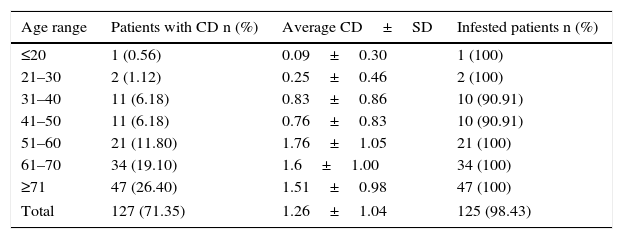To determine prevalence of Demodex spp. and infestation index (II) by the parasite among patients of different ages with blepharitis and to assess association with occurrence of cylindrical dandruff (CC).
Materials and methodsProspective study including patients diagnosed with posterior blepharitis between 2013 and 2015, without previous acaricide treatment, was conducted by Fundación Oftalmológica Los Andes (Chile). Four eyelashes were randomly extracted from each eyelid for parasite detection. The II was calculated as the ratio between the total number of demodex specimens found in the total number of eyelashes removed. A semi-quantitative determination of the CC was performed.
ResultsA total of 178 patients (91 men, 87 women), with a mean age of 58.49±20.66 years, were included. It was found that 83.7% of patients were infested with Demodex folliculorum with a mean II of 0.96±0.84 mites/eyelash. The II was significantly higher in patients over 50 years (p<0.0001). Patient age and II showed a Pearson correlation coefficient (R2) of 0.12 (p<0.0001). CC was observed in 71.4% of patients, with those over 50 years-old showing significantly higher values. A positive correlation was also observed between the amount of CC and the II (R2=0.33; p<0.0001).
ConclusionsThe prevalence of infestation by D. folliculorum is high in patients with posterior blepharitis. The II by the parasite is positively correlated with age and with the occurrence of CC on the eyelid border.
Determinar la prevalencia e índice de infestación (II) por Demodex spp. en pacientes con blefaritis en distintos grupos etarios y evaluar su asociación con la presencia de caspa cilíndrica (CC).
Materiales y métodosEstudio prospectivo que incluye a pacientes de la Fundación Oftalmológica Los Andes (Chile), con diagnóstico clínico de blefaritis con compromiso de la lámina posterior entre 2013 y 2015, sin tratamiento acaricida previo. Cuatro pestañas de cada párpado fueron extraídas al azar para la detección del ectoparásito y determinación del II, calculado como el cociente entre el número observado de especímenes de demodex y la totalidad de las pestañas extraídas. Además, se realizó una determinación semicuantitativa de la presencia de CC.
ResultadosSe incluyó a 178 pacientes, de los cuales el 51,3% eran hombres. La edad promedio fue de 58,49±20,66 años. El 83,7% de los pacientes resultaron infestados por demodex, con un II promedio de 0,96±0,84 ácaros/pestaña. El II fue significativamente mayor en pacientes sobre los 50 años (p<0,0001). La edad de los pacientes y el II presentaron un coeficiente de correlación lineal de Pearson (R2) de 0,12 (p<0,0001). El 71,4% de los pacientes presentaron CC, con valores significativamente más altos en pacientes mayores de 50 años. Se observó una correlación positiva entre la cantidad de CC y el II (R2=0,33; p<0,0001).
ConclusionesExiste una elevada prevalencia de infestación por demodex en pacientes con blefaritis posterior. El II por D. folliculorum se correlaciona positivamente con la edad de los pacientes y con la presencia de CC en el borde palpebral.
Artículo
Comprando el artículo el PDF del mismo podrá ser descargado
Precio 19,34 €
Comprar ahora













